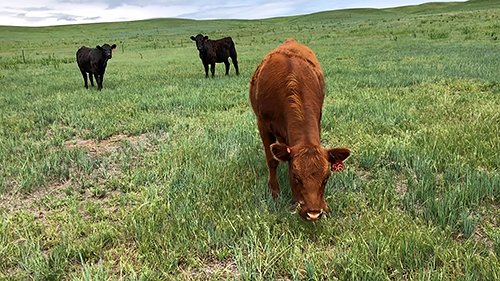Targeted Grazing, A Successful & Low-Cost Method to Manage Cheatgrass When Timed Properly
Contact: Maribel Alonso
Email: Maribel.Alonso@usda.gov
For media inquiries contact: Maribel Alonso, (301) 467-0667
October 1, 2024
Targeted livestock grazing is a successful and cost-efficient method to manage cheatgrass in the U.S. western Great Plains when timed to coincide with cheatgrass growth rather than based solely on the time of year, according to a recent study published by USDA’s Agricultural Research Service (ARS) and the University of Nebraska–Lincoln (UNL).
Findings show the targeted grazing window lasts approximately 38 days in the spring, with some variation depending on the year and location.
Cheatgrass (Bromus tectorum) is an annual grass native to Eurasia that has become one of the most problematic invasive species in the western U.S. This invasive species outcompetes native vegetation in the spring, and after completing its growth, it dries into fine fuels during the summer, leading to more frequent, widespread wildfires.
One low-cost method is known to help manage this problem. Early spring targeted grazing, where cattle are allowed to graze cheatgrass early in the season at the right time, can help limit seed production and reduce the competitiveness of cheatgrass. However, what is the right timing for this grazing method to be successful?
ARS Research Ecologist Dana Blumenthal, one of the co-authors of the recently published paper, explains a key finding of the study, “Cattle are very predictable in when they like to eat cheatgrass. Producers can effectively graze it from when it’s four inches tall until it’s done flowering, and the seeds are hardening up. That is a window of about a month to a month and a half. The window moves around from year to year, so it’s important to use cheatgrass growth as a guide for when to graze rather than calendar dates.”
 Spring heifer grazing on cheatgrass. (Photo courtesy of Julie Kray, ARS.)
Spring heifer grazing on cheatgrass. (Photo courtesy of Julie Kray, ARS.)
Researchers at the ARS’ Rangeland Resources & Systems Research facility (with locations in Colorado and Wyoming) and the UNL’s Panhandle Research and Extension Center collected data from mixed-grass prairie sites in the western Great Plains, including Nebraska and Wyoming, over a period of four years. The scientists identified pastures with areas of cheatgrass intermixed with native plant communities and grazed them with yearling cattle from April through June. Samples of fecal material from the grazing cattle were collected twice a week and analyzed to determine the proportion of different grass species in their diets.
Researchers measured vegetation phenology (height and flowering stage), forage quality, and biomass of cheatgrass and coexisting native plant species. These measurements helped them compare the differences in cattle selection for plant species and forage quality over the four years.
“We were surprised by how late in the season the cattle kept using cheatgrass. That’s really helpful because it gives producers more time to get cattle out into cheatgrass areas and have an impact,” said Blumenthal.
Results of this four-year study showed that grazing can be timed effectively by keeping track of two easily observable cheatgrass characteristics – height at the beginning of the grazing window and seed maturity later on. The resulting grazing windows, on average across the years of this study, were seven days longer in the western Nebraska site compared to the southeastern Wyoming site. In terms of impact, results showed that targeted grazing in the early spring can reduce seed production of cheatgrass by as much as 77 percent when compared to summer grazing. Furthermore, spring targeted grazing can lead to favorable cattle weight gains due to higher crude protein and energy in cattle diets during this period.
“Moving forward, we’d like to learn in which years grazing has the largest effect on cheatgrass seed production. Is it when cattle eat more cheatgrass because the plants are larger, or when cheatgrass is already struggling to grow, for example, in a drought?” said Julie Kray, an Agricultural Science Research Technician with the Rangeland Resources & Systems Research facility. “We know that multiple years of targeted grazing will be needed to control cheatgrass, but there may be certain years in which it is more important to prioritize grazing it.”
Visit “Targeted grazing to control cheatgrass in mixed-grass rangeland” for more details about this study.
The Agricultural Research Service is the U.S. Department of Agriculture's chief scientific in-house research agency. Daily, ARS focuses on solutions to agricultural problems affecting America. Each dollar invested in U.S. agricultural research results in $20 of economic impact.
